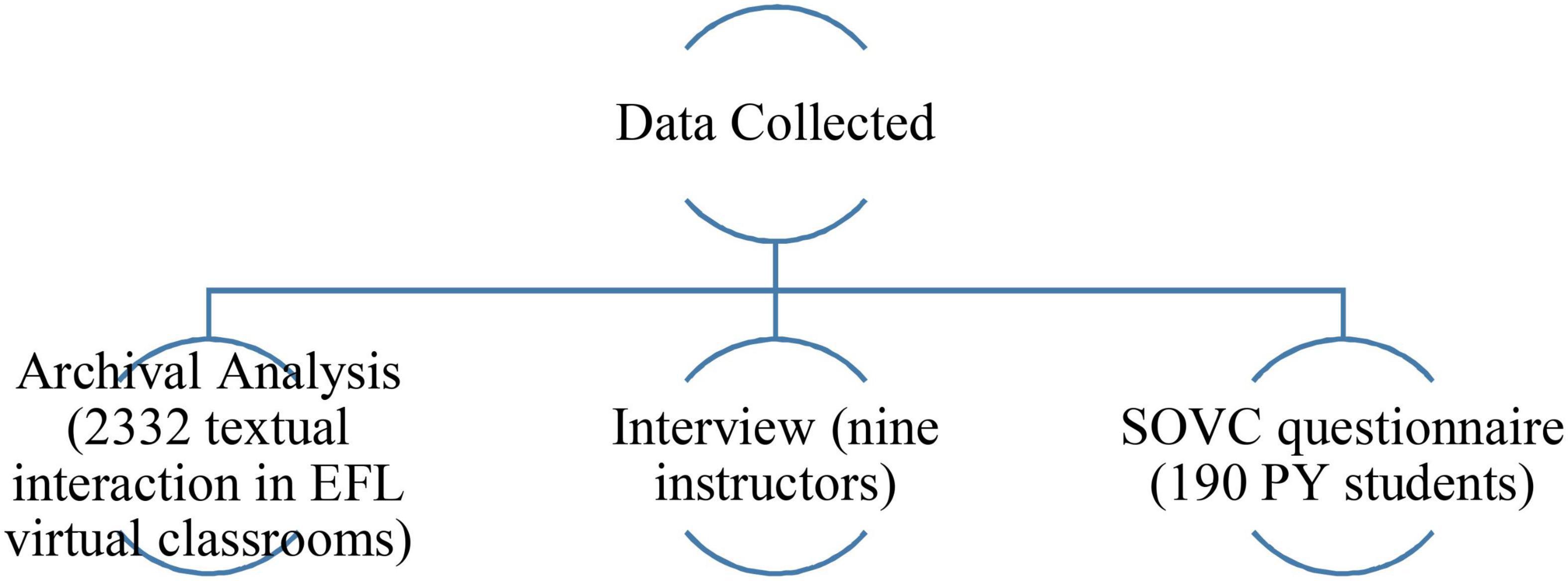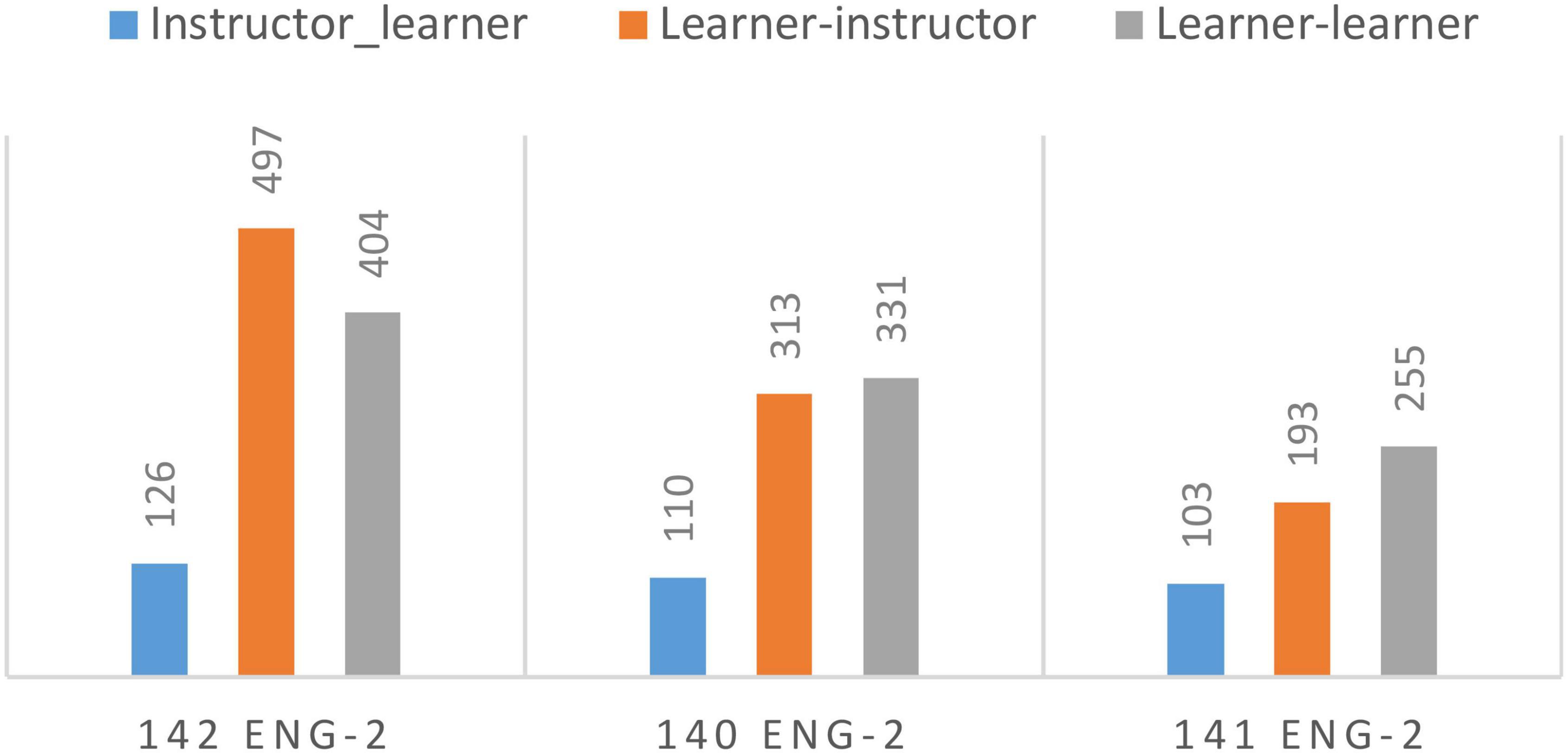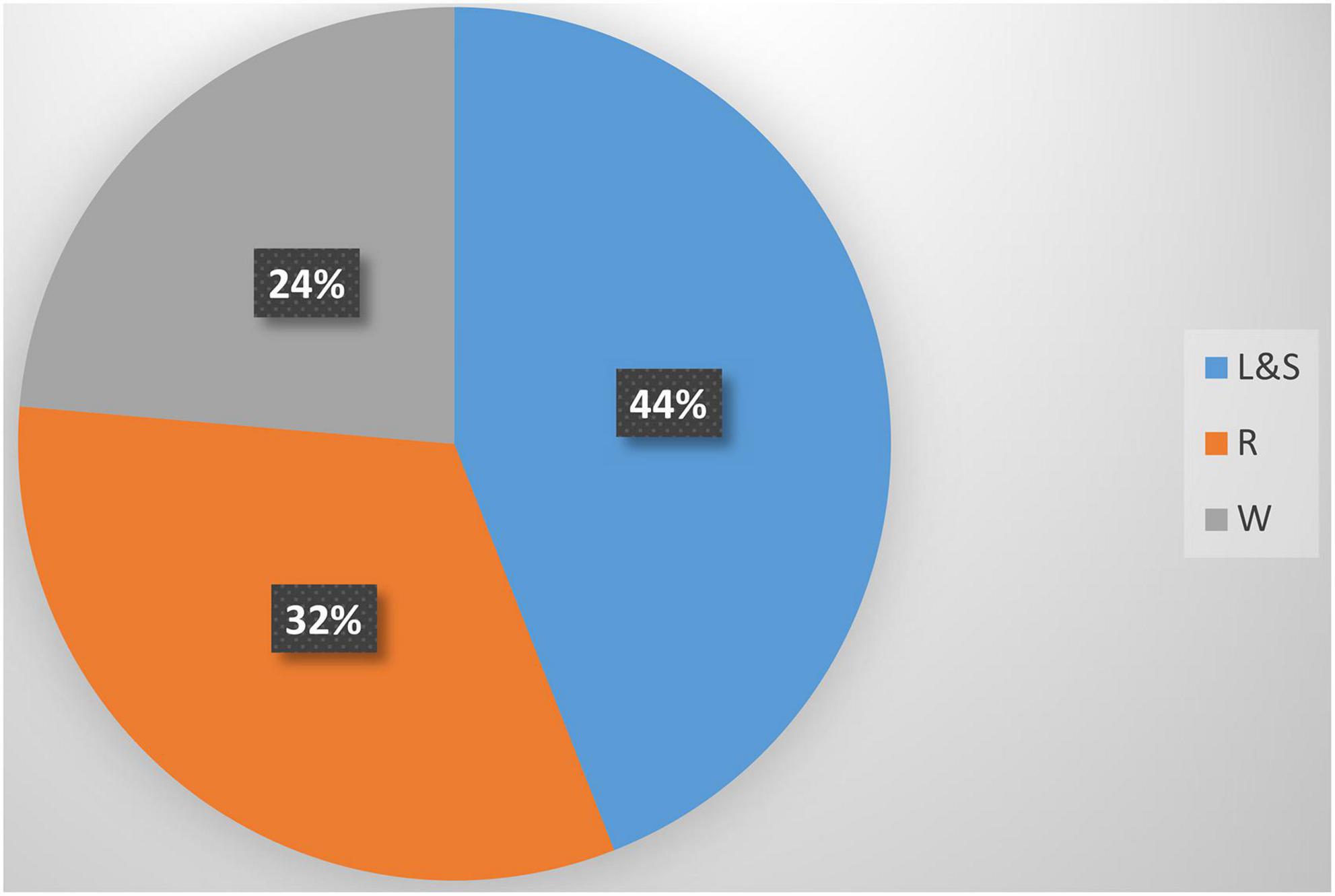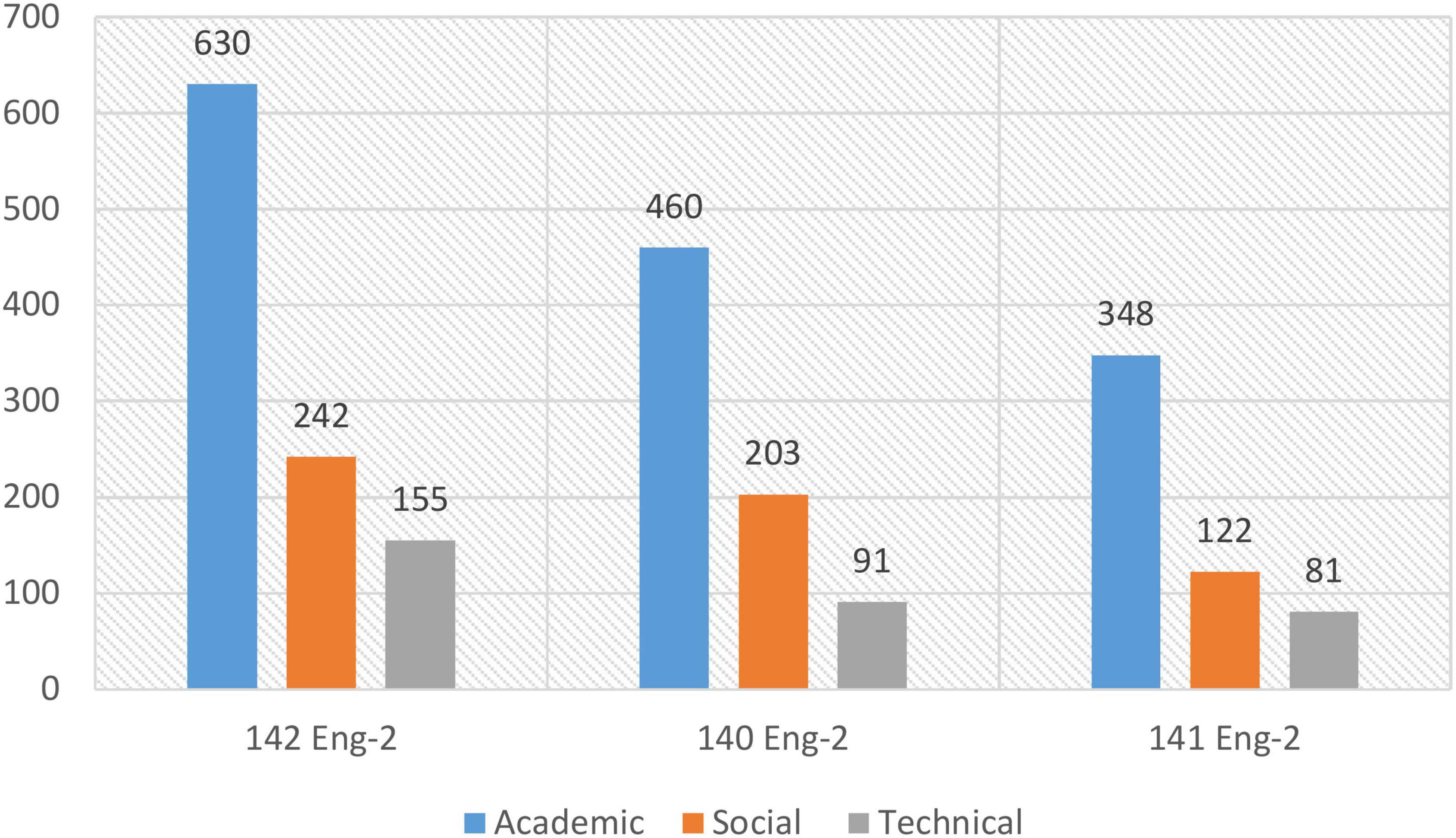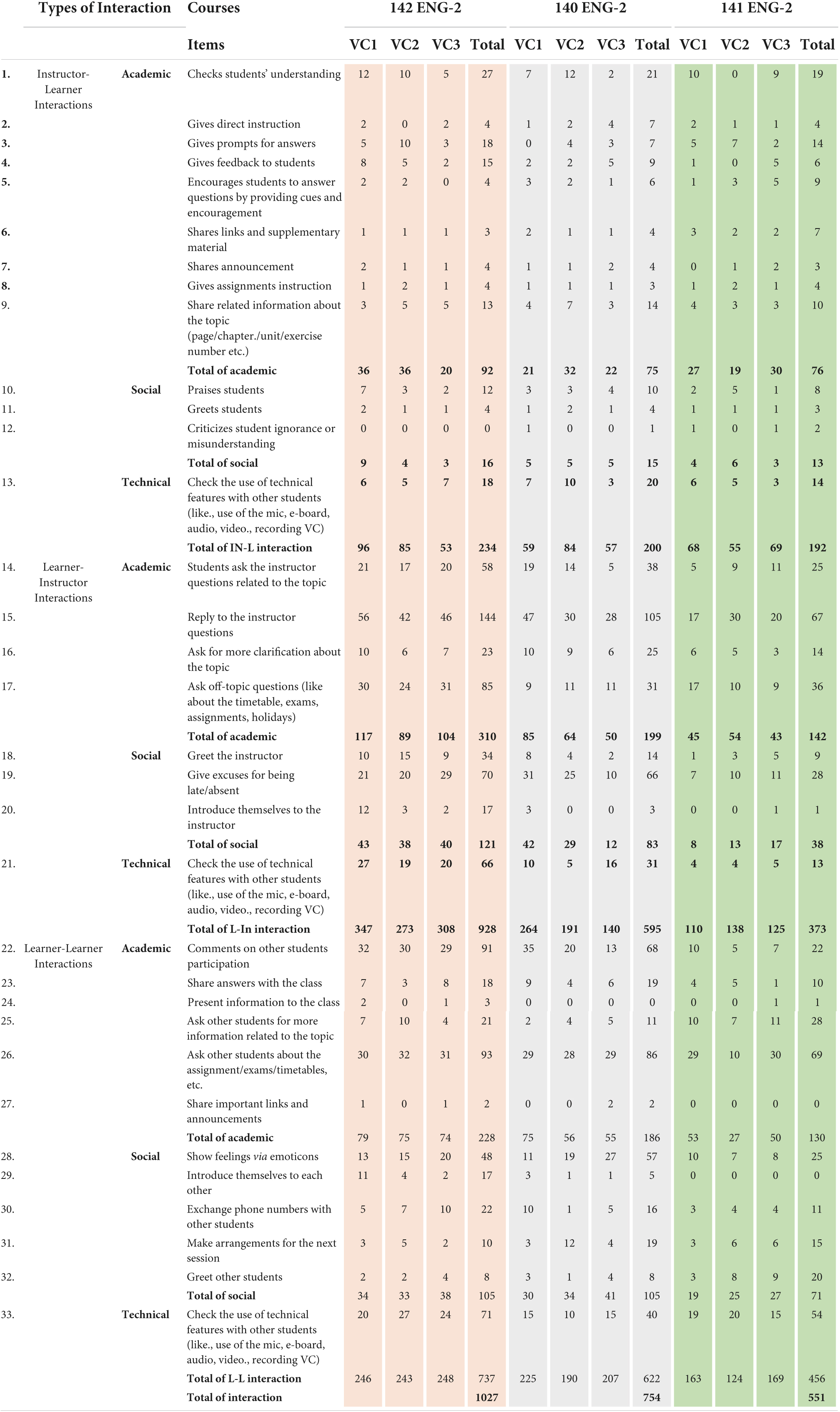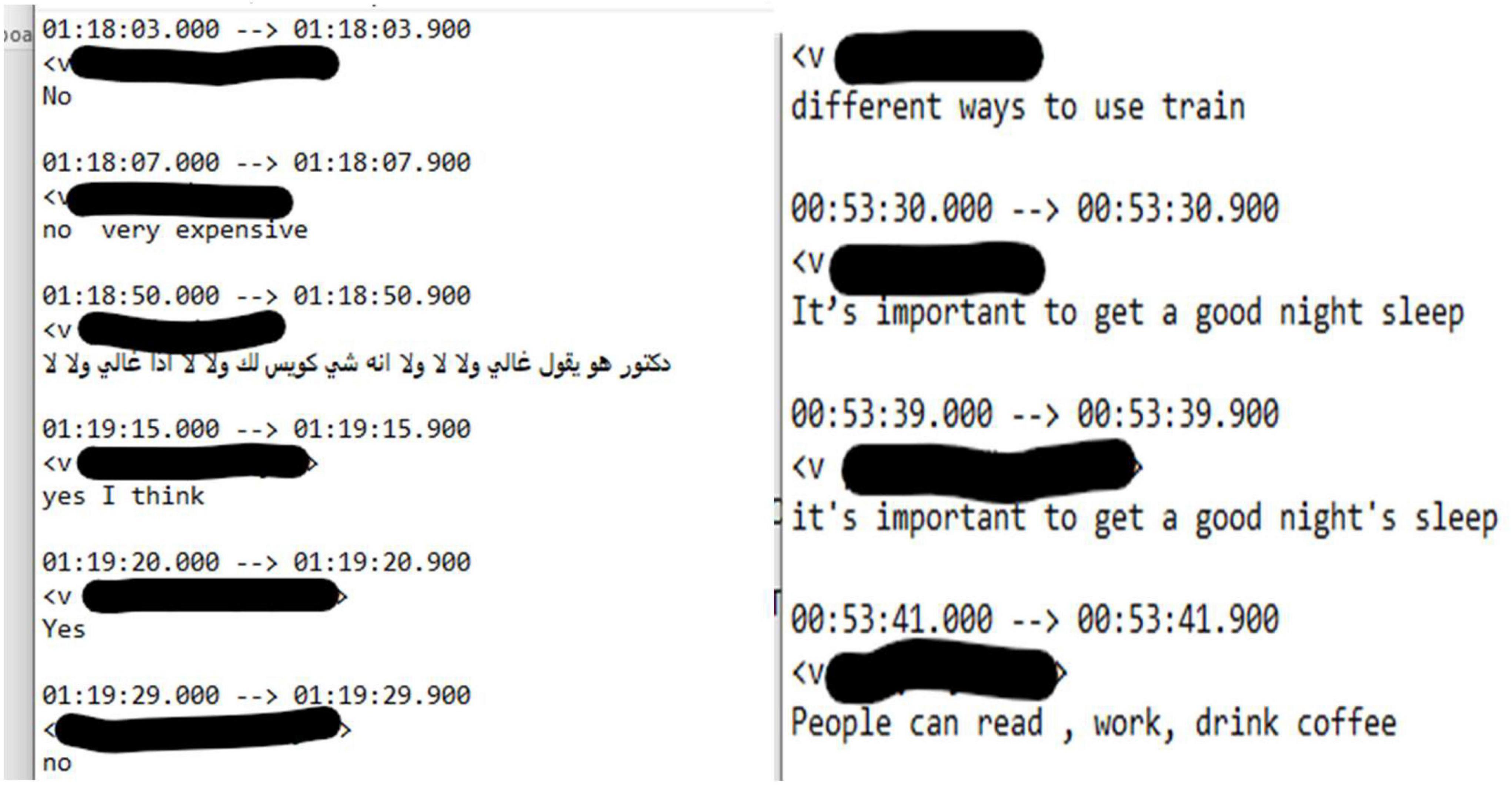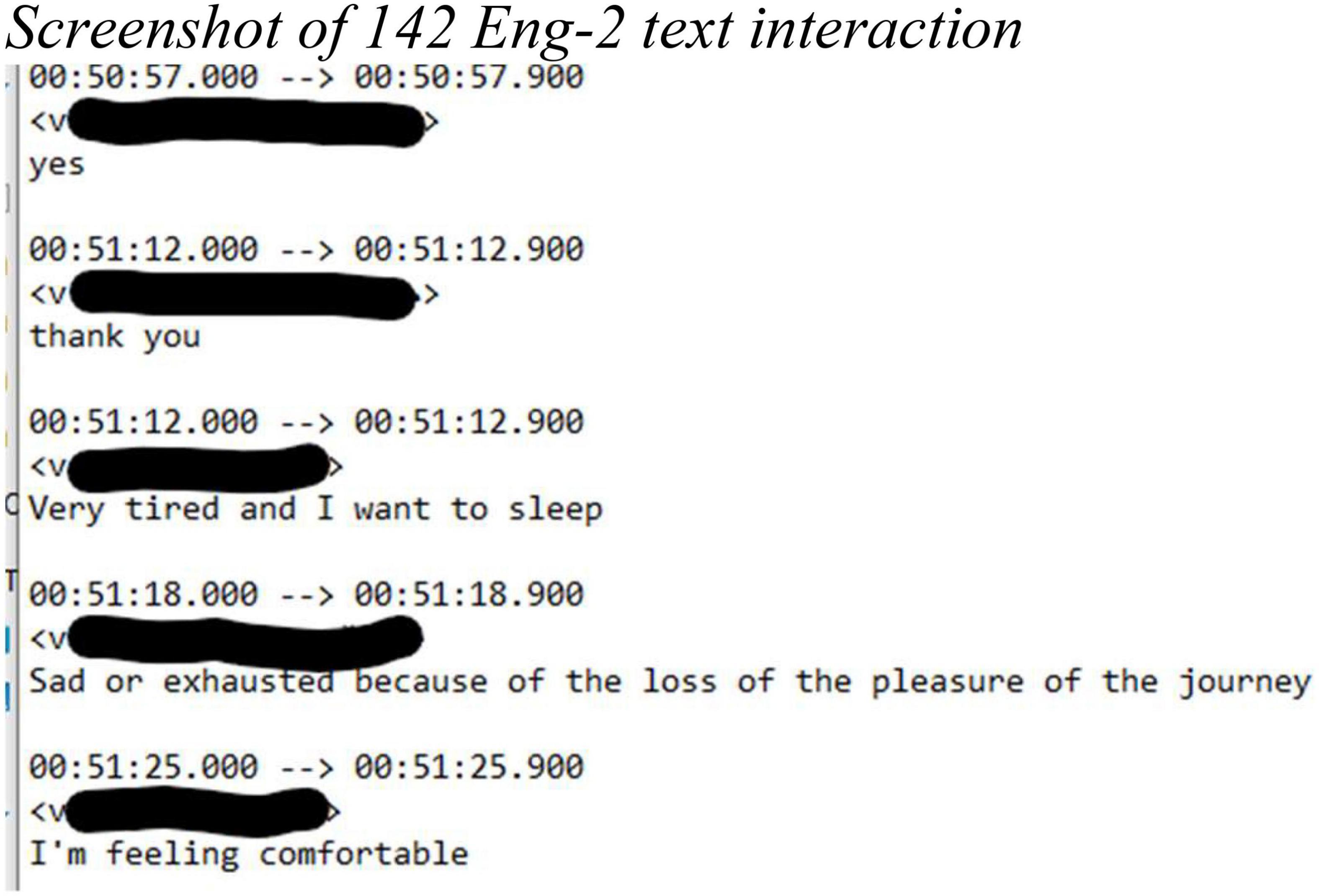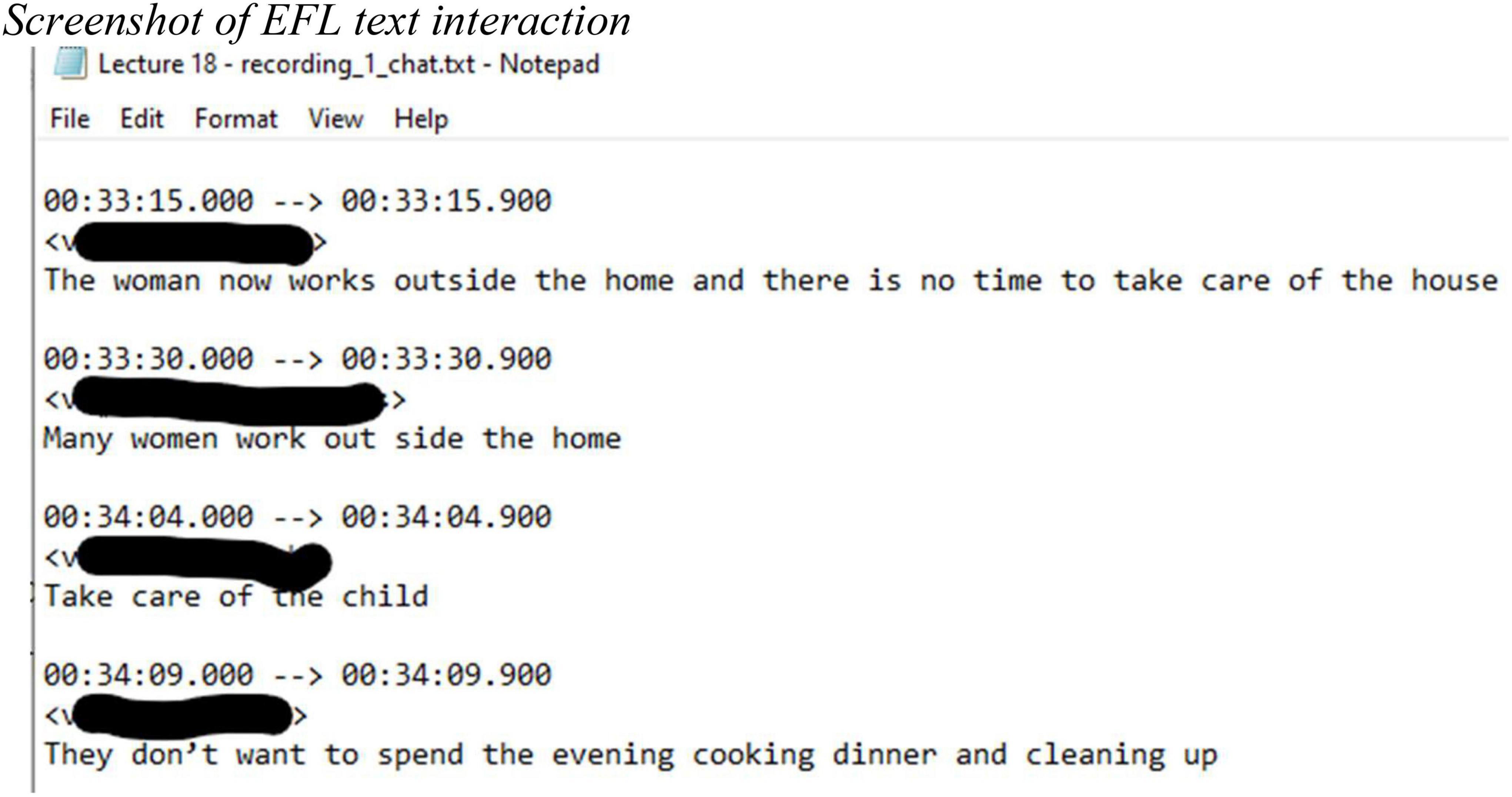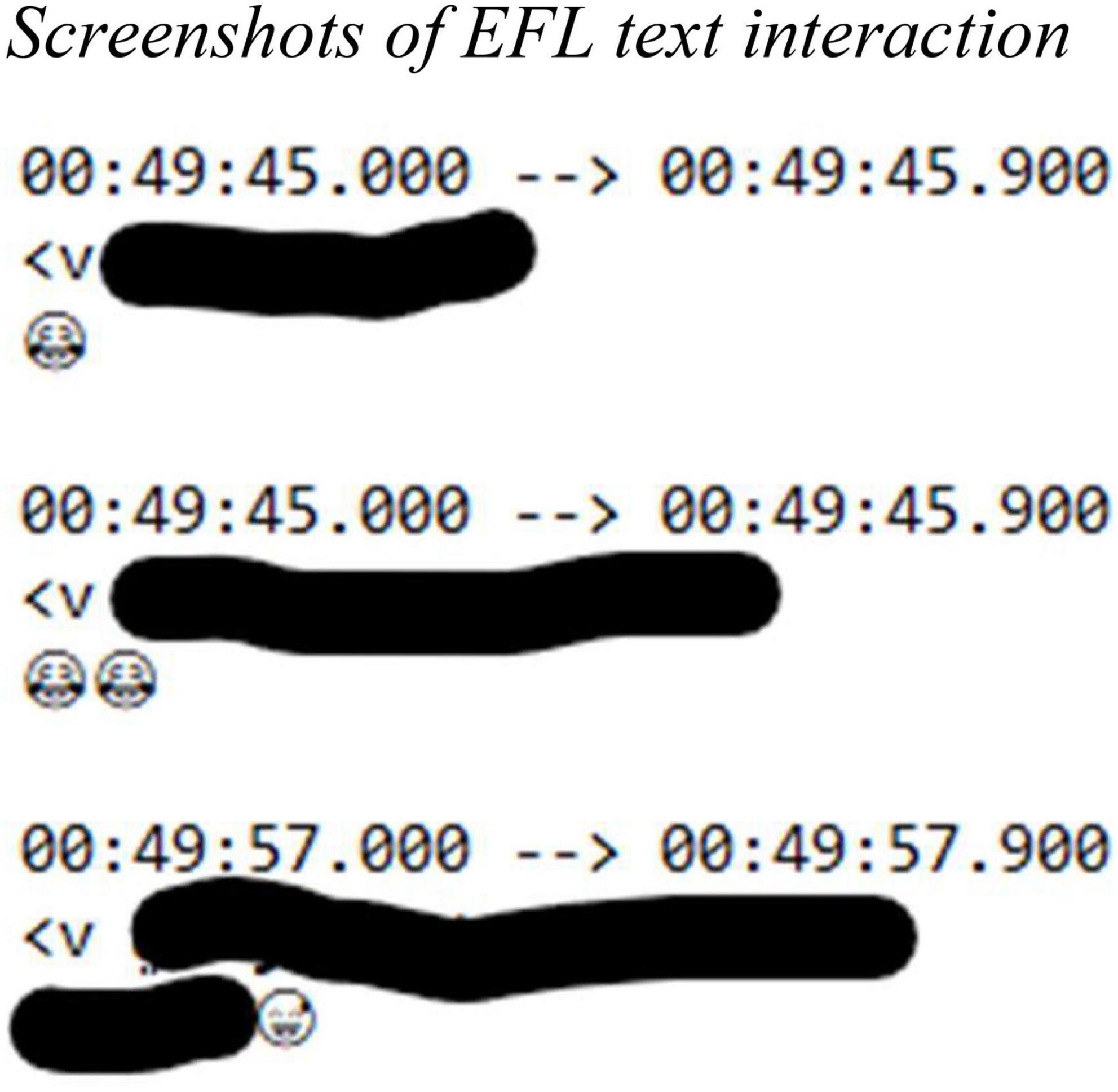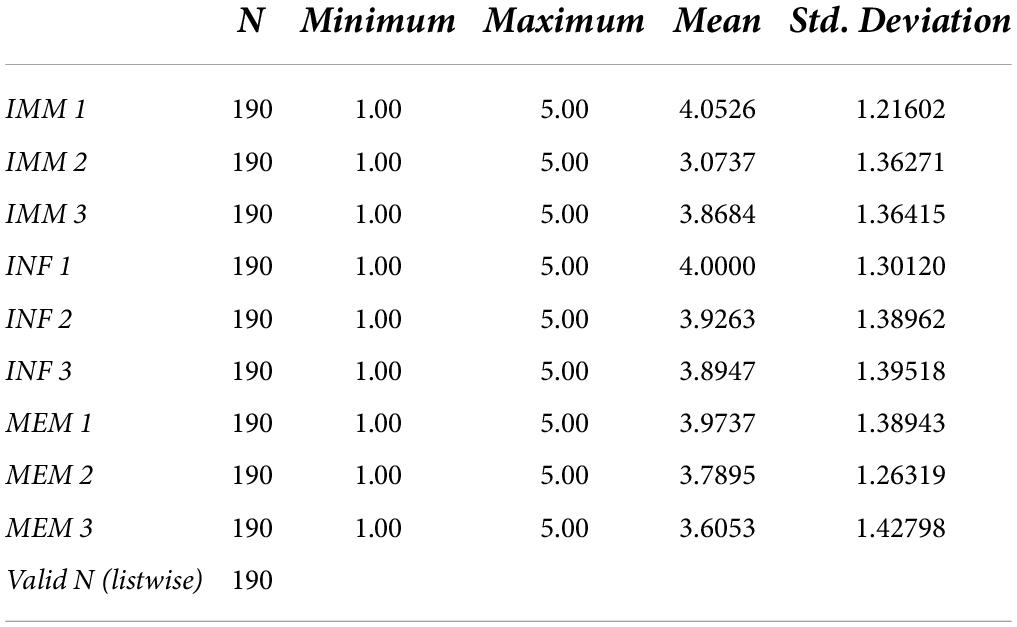- Department of English, Najran University, Najran, Saudi Arabia
The era of COVID-19 compelled universities to design and deliver courses online. However, the successful design and delivery of online courses should embrace community. This study correlates the actual use of text interaction in English as a Foreign Language (EFL) virtual classes (VC) and its impact on the sense of virtual community (SOVC). To achieve the study’s goal, three groups of preparatory year (PY) students at Najran University studying online through Blackboard in the era of COVID-19 represent the participants. The study used data sources of the analysis of nine archival data of Reading course, Listening and Speaking course, and Writing course VC using Schullo model and the SOVC questionnaire adopted from Koh and Kim and an individual interview of nine instructors to get thorough interpretations of text interaction during VC. The study provided detailed information about what type(s) of text interaction participants used in EFL virtual classrooms. It also explored the impact of VC text interaction on EFL students’ SOVC. The study found that text interaction in EFL VC enhanced students’ SOVC. The findings supported that text interaction had both academic and social values. The study contributed to the theory of SOVC and brought recommendations on how educators can take advantage of VC text interaction in the EFL context.
Introduction
The COVID-19 outbreak changed the educational scenario all over the world. Several studies have examined teachers’ and learners’ perceptions of the sudden switch from traditional to online learning in the English as a Foreign Language (EFL) context (Almekhlafy, 2020; Bao, 2020; Toquero, 2020; Zhang et al., 2020; Hargis and Lu, 2021; Quinn and Paretti, 2021). However, this sudden switch brings new and different environments to the learning and teaching situation (Berry, 2019; Chatterjee and Correia, 2020; Ahmed, 2021; Chen et al., 2021; Willermark, 2021; Wut and Xu, 2021), particularly in the way of virtual classes (VC) interaction (Duchêne et al., 2020; Chen et al., 2021; Willermark, 2021). In Saudi universities, educators face entirely different and new conditions as the teaching and learning process is conducted remotely. In 2020 and 2021, students received their education solely online using the Blackboard program.
Blackboard is an integrated platform that includes various features used for course delivery like VC and student management tools like grade-center (Almekhlafy, 2020). Blackboard VC is embedded with multiple components that allow students and the instructor to interact in VC using video, audio, and text. The components are an e-board, audio device (mic), and text-based interaction. By utilizing the VC-embedded components, students can interact with peers and instructors as they do in face-to-face classrooms (Wut and Xu, 2021).
Text interaction during VC sessions strongly influences creating and sustaining of a practical VC setting (Berry, 2019; Wut and Xu, 2021). The constant interaction aims to increase students’ engagement and sense of virtual community (SOVC) (Chatterjee and Correia, 2020; Chen et al., 2021; Willermark, 2021). According to Suominen and Jussila (2021), experiencing a SOVC is essential for students and various social aspects of learning in a virtual community like VC. To them, SOVC includes the feelings of the individual, which makes it an intricate concept that encompasses collaborative work and fulfilling one’s social needs. Text interaction also compensates for the lack of physical presence by engaging students in a comfortable environment, particularly those who have the anxiety of using the mic to talk. Text interaction is a proper channel for learners to interact freely (Russell and Murphy-Judy, 2020). Schullo (2005) found that instructors used text and audio the most among the many features of VC available. Instructors mostly use e-board, text, and audio interaction in Saudi universities.
Given the importance of text interaction in the EFL context, there is still an open question of what type(s) of text interaction support students’ SOVC. The “text” interaction role in the VC from the perspective of SOVC in the EFL context in the era of the COVID-19 outbreak is still unclear. This study tries to fill the existing gap.
Literature review
The sense of virtual community
When defining the sense of community (SOC) as the feeling of relationship with others and individuals’ feelings of membership, the same will be observed in the online community known as SOVC. The SOVC was defined by Koh and Kim (2003) as the degree of affective attachment to a given community mediated by technology; in the study case, VC features. Abfalter et al. (2012) defined SOVC as the personal feeling of affection and belonging to a virtual community that occurs because of technological interaction. Tonteri et al. (2011) described SOVC as the individual’s feeling of community in an online setting. Similarly, Blanchard (2007) defined SOVC as individuals’ feelings of membership, identity, belonging, and attachment to virtual communities that communicate through online features. SOVC is an indicator of the success of online communities (Chatterjee and Correia, 2020). This concept of SOVC increases its importance in the online learning environment. For example, Baker and Moyer (2018) found that students who experienced SOVC had a better impression of online courses. Similarly, Chatterjee and Correia (2020) explored students’ interaction, collaboration, and SOVC and found that they were correlated. Their results recommended that educators use various strategies and features to enhance SOVC. They also added that educators enhance students’ engagement in online courses by doing that.
This study operationalizes SOVC as having three dimensions, namely, immersion, membership, and influence. As defined by Koh and Kim (2003), membership or a sense of belonging has a substantial impact on the use of tools and features offered in the virtual community (Naranjo-Zolotov et al., 2019). Therefore, students in VCs who use text interaction may benefit from feeling membership even if they are far from each other. Influence is the level to which a member distinguishes that they can influence others by sharing views and ideas (Hsiao and Chuang, 2009). VCs in Blackboard facilitates various ways of interaction among students. Students are likely to be influenced by each other’s views and ideas. In the context of the VC, immersion is the state of flow a student might have once using text interaction features (Koh and Kim, 2003). Students, for example, may find the topic of a VC interesting, go on interacting and thereby arrive at some level of immersion (Naranjo-Zolotov et al., 2019). Text interaction involves students in VC and positively impacts their learning environment. Berry (2019) studied how various features of VC influence students’ SOC and found the interaction, either oral or textual, acts as a trigger to learning online.
Text interaction in online classes
Research in ESL/EFL acquisition has mainly revolved around two theoretical approaches concerning online learning and language acquisition: cognitive and sociocultural approaches (Namaziandost et al., 2021). From the perspective of the cognitive approach, language acquisition is a mental activity, and for the sociocultural theory, meaning is constructed through social interaction. Later, the socio-cognitive theory was embarked upon, in which the online learning environment becomes a tool that facilitates social interaction among learners, provides input, and elicits output from the learners (Namaziandost et al., 2021).
In VCs, using more than one form of interaction (oral, visual, or textual) facilitates learning. Through text interaction in the VC, students can participate, comment, and provide feedback to others concurrently (Chen et al., 2021). Previous studies (Cook et al., 2011; Martin and Parker, 2014; Berry, 2019; Russell and Murphy-Judy, 2020) suggested that constant text interaction in synchronous VC enhanced learning. For example, Cook et al. (2011) stated that students find text interaction as a safe zone to participate during the VC. Similarly, Martin and Parker (2014) noted that the text interactions in VC enhance a SOC among learners and help instructors engage all students throughout the session. In other words, text interaction in VC creates constructive conditions that lead to a more effective learning environment.
Moreover, Berry (2019) summarized the benefits of text interaction in VC: it is helpful for less vocal students (more comfortable), allowing all students to participate and maintaining students’ engagement in long class sessions (exchange jokes and friendly comments). Therefore, text interaction in VC creates an engaging and supportive learning environment. It is an open stage for students to participate educationally and socially (Berry, 2019). Cook et al. (2011) and Russell and Murphy-Judy (2020) supported the usage of text chat and believed that text interaction promotes community and collaboration.
The virtual classroom situation differs from face-to-face classrooms as it is impossible to use the same social interaction (Willermark, 2021). That is why text interaction is equipped with emojis and emoticons to invoke the appropriate conditions for text interaction. Students will enable them to express their feelings quickly and smoothly (Vu and Fadde, 2013; Sarkheil and Azarnoosh, 2014; Wut and Xu, 2021). According to Oxford (2017), the interaction contains three sets, namely, asking questions (clarification, verification, correction), cooperating, and empathizing with the community. However, recently, Oxford (2017) emphasized collaborative strategies. According to them, students use text interaction to ask for corrections, netiquette, request clarification, and verification (Chen et al., 2021). Their data showed students’ SOC improvement when they frequently use emoticons and emojis in text interaction.
Similarly, Berry (2019) found that students use text interaction to ask questions, clarify, or comment on others’ comments. Although one or two students can use the mic to participate at once, all the class can participate using text interaction simultaneously. In addition, emoticons like laughter, applause, and agree and disagree icons are trendy among all groups using text chat tools during the VC. A positive comment permits the students to realize that they are concerned about their learning.
A researcher should follow a precise criterion when analyzing the synchronous interaction. Researchers and theorists used different criteria when analyzing synchronous interaction. For example, Andersen (1979) dwelled on the synchronous interaction under sharing, comparing, negotiating, and testing knowledge. Roblyer and Ekhaml (2000) framed the analysis of synchronous interaction under social, instructional, and types and uses of technology. Northrup (2001) divides the synchronous interaction into personal interaction with context, collaboration, converse, help monitor, and support performance. When analyzing the synchronous interaction, Veldhuis-Diermanse (2002) focused on different learning activities and the quality of constructed knowledge. Schullo (2005) also categorized synchronous interaction under social, academic, and technical dimensions. Researchers selected Schullo’s (2005) models because they provide a more appropriate EFL context than other models.
During the COVID-19 outbreak, most Saudi universities used the online platform–Blackboard (Almekhlafy, 2020; Hazaea and Toujani, 2021). To ensure the VCs enhance students’ engagements, one should highlight the importance of using various features available in the VC (Willermark, 2021). Even though the extensive use of Blackboard and the volume of VC within it, very few studies have been conducted on how technical facets of VC affect online students’ academic or social experiences. Although few studies focus on audio and video interaction in the VC, to the researcher’s knowledge, no study focuses on what and how EFL learners use text interaction during live VC sessions during the era of COVID-19 in the EFL context. Thus, this study aims to answer the following questions:
1. What type(s) of text interactions do EFL students use in EFL VCs?
2. To what extent does text interaction in VC increase EFL students’ sense of community?
Materials and methods
To answer the above questions, the study collected data through three sources: the SOVC questionnaire was first developed by Koh and Kim (2003) and later used by Naranjo-Zolotov et al. (2019), and nine VC chat reports were produced by Blackboard Collaborate Ultra and interviews. The mixed-method design included a quantitative method followed by a qualitative method (Creswell et al., 2003) to investigate the correlation between the students’ text interaction in the VC and their SOVC.
The Scientific Research Ethical Committee issued an ethical approval (Ref. 443-50-24962-DS) for the study. The data collection and study methods strictly followed the ethical procedures required by Nanjran University, represented by the Scientific Research Ethical Committee, and all norms were rigorously in compliance. The study goals were explained to participants prior to the study that the required data would be taken with complete confidentiality and used only for research purposes to maintain participants’ privacy.
This study was conducted with EFL students at the tertiary level [specifically Preparatory Year (PY) students]. Nine VC of reading (140 Eng-2), listening and speaking (142 Eng-2), and writing (141 Eng-2) courses were chosen randomly for archival data. In addition, nine instructors were interviewed as well, and a SOVC questionnaire was dispensed among level one students of the PY.
Instruments
Three instruments were used in this study. The first instrument is Blackboard archived reports of VC sessions. The researcher systematically reviewed the text interactions during VC sessions (Schullo, 2005). In total, nine archived sessions were randomly selected and analyzed to further understand the actual types and ways of text interaction during EFL VC sessions of three-course courses, namely, three reading 140 ENG-2, three listening and speaking 142 Eng-2, and three writing 141 Eng-2. The archival data were analyzed using Schullo’s (2005) theory which aimed to measure the types of interaction in the virtual classroom.
The second instrument was a semi-structured interview conducted with nine instructors at PY, Najran University. The purpose of the interview was to obtain detailed accounts (Burino et al., 2017) of interaction in the virtual classroom from instructors’ perspectives to help elaborate on the quantitative results of the SOVC questionnaire and data collected from Blackboard reports (Creswell et al., 2003).
The last instrument in this study was the SOVC questionnaire. The SOVC questionnaire consists of closed-ended questions on a 5-point Likert scale. The questionnaire was adapted from Naranjo-Zolotov et al. (2019) and fell under three dimensions of SOVC (Koh and Kim, 2003), namely, membership, influence, and immersion. The statements of SOVC were rated from 1 to 5 (1 = never, 2 = seldom, 3 = sometimes, 4 = mostly, and 5 = always). The statements were declarative, and students chose the level of engagement.
The SOVC questionnaire, as mentioned earlier, was adopted from Koh and Kim (2003). Few modifications were applied to suit the purpose of the study. The “e-participation” in Koh and Kim (2003) has been replaced by “text interaction in VC.” After that, the SOVC questionnaire was piloted with 20 participants and the internal consistency was measured to ensure its reliability with Cronbach’s alpha (CA) (Table 1).
The pilot study demonstrated the calculation of Cronbach’s reliability coefficient of the SOVC questions was CA.941.
Finally, to ensure that the participants had a clear understanding of the SOVC questionnaire and its items, the questionnaire was translated into Arabic (the participants’ mother tongue).
Data analysis
The interaction analysis included 33 items on different interactive elements of Schullo’s (2005) to analyze nine virtual classrooms’ synchronous text-based chat. The synchronous textual chat study was classified according to the type of interaction, namely, instructor–learner, learner–instructor, and learner–learner interaction. The further classification was formed according to the purpose of the interaction, namely, academic, social, and technical interaction. The synchronous textual interactions related to course content were considered academic, interactions associated with the use of different features of VC were technical, and other than the previous text interactions were deemed social. The archival data were linked to the data obtained from the instructor interview and students’ questionnaires.
The results
The data were collected from three sources, namely, nine virtual classroom archival analyses, an interview of nine instructors, and a SOVC questionnaire consisting of nine items. Figure 1 shows the statistics of the data collected.
Archive analysis
The total number of text interactions in the nine VCs was 2,332; most were academic in purpose. However, there were also synchronous textual interactions related to social and technical purposes (Table 1).
In total, 33 items were used to analyze the textual interaction in the nine virtual classrooms of three EFL courses. The total number of interactions analyzed was 2,332, divided among the three types of interaction, namely, instructor–learner interaction was 339, learner–instructor interaction was 1003, and learner–learner interaction was 990, which is summarized in Figure 2.
The archival data summarized in Figure 1 showed that students preferred to use synchronous text chat to interact with their instructor or other students in the virtual classroom. The instructors’ interview confirmed this, stating that most of the interactions happened in their VC through “audio and chat” features.
It also showed that the listening and speaking skills course (142 Eng-2) constituted the highest number of interactions, which was 1,027. The second one was the reading skill course (140 Eng-2) with 752, and the least was the writing skill course (141 Eng-2) with 551. According to the course-wise archival data, the listening and speaking virtual classrooms obtained the highest number of text interactions, which constituted 44%, as shown in Figure 3.
The archival data also showed the difference in the purpose of text interaction in the nine virtual classrooms of the three EFL courses (Figure 4).
The data indicated that students used textual interaction mostly for academic purposes with 61.66%. For example, “reply to instructor question” achieved the highest number according to the archival analysis shown in Table 2. The picture of 142 Eng-2 virtual classrooms is given in Figure 5.
Students reply to the instructor’s questions as shown in the screenshot of text interaction in EFL virtual classrooms. The instructor presented a picture of London and asked students what would they have done there? Through audio or sometimes textually, students reply as shown above. Similarly, the instructors reported in the interview that they use the text chat feature to check students’ understanding, give feedback, share important links, and give assignment instructions. Regarding how it helps students in virtual classrooms, instructors reported that it helped them reply to instructor questions and freely ask questions. They do not feel shy about sharing their answers and comments textually. Therefore, in the text interaction, the “responding to instructors” item achieved the highest number of interactions. Another example is taken from 140 Eng-2 virtual classroom interactions (Figure 6).
As shown in the interaction above, students share in peer discussion with the goal of finding the answer to the instructor’s questions. Students used the Arabic language (mother tongue) to convey meaning or concepts in a few cases, which were emphasized in the interview with instructors. They reported that English was used mainly in text interaction. The third example is taken from 142 Eng-2 VC, where students reply to the instructor’s question, as shown in Figure 7.
The above examples reveal that text interaction in an EFL context is mainly used in a virtual classroom for academic purposes. However, social interaction was notable in the text interaction in EFL virtual classrooms with 24.31% compared to the technical interaction with 14.02%. Instructors also stated that the contribution of text interaction features to the virtual community is notable. They reported that students used text chat not only for academic purposes but also to discuss some social issues, greet each other, introduce themselves, share phone numbers, and make arrangements (Figure 8).
Some social issues were discussed in 142 Eng-2 virtual classrooms. Students freely expressed their opinions about social issues like the women working outside. Instructors stated that the text chat feature helped instructors know their students’ names and build rapport. Meanwhile, students used emoticons to show their feelings, as shown in Figure 9.
When instructors were asked about the characteristics of the chat feature, they stated that chat is familiar to students as it is similar to WhatsApp and other types of the messenger. They added that chat in virtual classrooms encouraged shy students to participate. Unlike the audio participation of students, text chat does interrupt the VC even if many students join at the same time. They also ensured the role of text chat in creating a SOC because students feel relaxed using text chat. At the end of the interview, the instructors expressed their satisfaction with text-based interaction in VC.
The SOVC questionnaire was distributed among PY students by the end of the semester. A total of 137 male students and 53 female students responded to the questionnaire. The questionnaire was adopted from Koh and Kim (2003), about SOVC dispensed among students in PY. CA assessed the internal consistency. The CA was 0.941, which showed the reliability of the questionnaire.
The three elements of the questionnaire showed positive effects of the text interaction in EFL VC on the SOVC (Table 3).
The IMM elements scored M 3.66 and SD 1.3142 while INF got M 3.94 and SD 1.36, and the last one was MEM with M 3.78 and SD 1.36. The results showed that all the elements scored high and reflected the influence of textual interaction in VC on SOVC. Among all the items of the questionnaire, IMM 1, “I like to interact with other students textually during English virtual classroom,” achieved the highest with M 4.1 and SD 1.21. Students showed a positive perception of text interaction during virtual classrooms and curiosity to interact through a text-based feature in VC. None of the other items in the three elements scores less than M 3.5. The least was IMM2 with M 3.7 and SD 1.31. Therefore, PY students at Najran University ensured the positive role of text interaction in creating students’ SOVC in the EFL virtual classroom.
Discussion
The study aims to determine the role of the text-chat feature and its impact on creating students’ SOVC in EFL VC. Data were collected from three sources, namely, archival data, interview, and questionnaire; the research questions were addressed and revealed how different text-based interactions in EFL VC promoted students’ SOVC. The results of the SOVC questionnaire demonstrated the strong role of the synchronous text interaction during EFL VC, and the questionnaire items had scores higher than M 3.5. Similarly, the results of the archival analysis showed that students preferred to interact with the instructor or the other students through text chat during EFL VC. Based on the archival analysis, around 1,993 out of 2,332 textual interactions occurred either between learner and instructor or learner and learner. In parallel, Shaharanee et al. (2016); Al-Qahtani (2019), Alahmadi and Alraddadi (2020), Hamouda (2020); Mutiaraningrum and Nugroho (2020), and Zain (2020) persuasively supported the tendency toward VC text-based interaction in EFL learning, as it enhanced communication and created a social presence, which resulted in students’ SOVC. Moreover, the instructors in the interviews emphasized the role of text interaction in EFL VC. They reported that text interaction encouraged shy students to participate which created a SOC among students in EFL VC. This aligns with the study by Russell and Murphy-Judy (2020), who found that text interaction promoted community and collaboration. Therefore, encouraging students’ use of synchronous text chat enhanced academic, social, and technical interaction in EFL VC. This is in line with the study by Berry (2019), who supported that in the EFL context, instructors should be encouraged to accommodate text interaction in virtual classrooms to be more appealing than conventional face-to-face interaction, develop, and utilize text interaction features in virtual classrooms as it provides an engaging and motivational learning setting.
Based on the archival analysis, the text-based interactions were sorted according to the purpose of the interaction, including academic, social, and technical. The finding supported that the synchronous text chat in VC had both academic and social values. It was also found that the text chat feature was critical as it provided feedback to the instructor regarding technical issues that could be resolved quickly with little disruption and the text chat provided learner–learner and learner–instructor interactions for social and content knowledge. This finding is consistent with those of Vu and Fadde (2013); Shaharanee et al. (2016), and Mutiaraningrum and Nugroho (2020), who reported that text-based interaction during VC, what some researchers called LVC, was the preferred mode for students to interact with instructors and respond or ask questions to clarify the details of statements, greet each other, discuss social issues, and find solutions to technical problems.
The study findings also indicated that students became more confident using the target language when they textually interacted in VC. They did not have anxiety and fear compared to audio and video features. This result is consistent with those of Hung and Higgins (2016); Kozar (2016), and Abalkheel et al. (2021), who compared text interaction to audio and video interaction where speaking in front of others might act as a source of communication apprehension that may provoke anxiety for many language learners.
In addition, the study found that the text chat feature provided an environment where learners could check, assess, and reflect on their performance through authentic feedback and actual interaction. This is in line with the study by Namaziandost et al. (2021), who found that learners interacted textually for academic purposes such as assessing and reflecting on their own participation and that of others.
Despite the inconsistency of text-based interaction among the three courses, the instructor used text-based chat for the same purposes. This finding aligns with the study by Kozar (2016), who found that some teachers used text chat frequently and others did not, but the chat was used for a similar function.
Conclusion
A notable conclusion was obtained from this study that a text chat feature in VC is essential to EFL students and instructors in online learning. At the top of the list is the capability to engage in two-way communication easily and quickly. For this, students and instructors appreciated the quality and ease of the text chat feature. In other words, the study findings indicate that online text chat is a prominent form of VC in terms of accessibility and use, which also enables students to generate real-time language. In addition, the ability to communicate in parallel with the instructor’s lecturing or other speaking is considered good to boost learners’ confidence in using the target language because text interaction can potentially alleviate learners’ anxiety and at the same time allow them to reflect on their interaction characteristics. Therefore, using text interaction features in the EFL, context can help instructors to conduct influential synchronous VC and promote students’ SOVC.
The study was conducted with a limited context in an EFL context, which could be better if tried out in more than one region to generalize results and get a broader picture of textual interaction in a different context.
Data availability statement
The original contributions presented in the study are included in the article/supplementary material, further inquiries can be directed to the corresponding author.
Ethics statement
The studies involving human participants was reviewed and approved by the Najran University Scientific Research Ethical Committee (Ref. 443-50-24962-DS). Written informed consent to participate in this study was not required from the participants in accordance with national legislation and the institutional requirements. Written informed consent was obtained from the individual(s) for the publication of any potentially identifiable images or data included in this article.
Author contributions
SA prepared the instruments, review the literature, analyzed the data, and wrote the manuscript. AA administered the questionnaire, collected the data, participated in the data analysis, and proofread the manuscript. Both authors contributed to the article and approved the submitted version.
Acknowledgments
We thankful to the Deanship of Scientific Research at Najran University for funding this work under the General Research Funding program grant code (NU/-/SEHRC/10/1059).
Conflict of interest
The authors declare that the research was conducted in the absence of any commercial or financial relationships that could be construed as a potential conflict of interest.
Publisher’s note
All claims expressed in this article are solely those of the authors and do not necessarily represent those of their affiliated organizations, or those of the publisher, the editors and the reviewers. Any product that may be evaluated in this article, or claim that may be made by its manufacturer, is not guaranteed or endorsed by the publisher.
References
Abalkheel, A., Zein, F., and Sultana, R. (2021). Effective synchronous virtual classroom techniques for efl teaching: a study based on instructors’ perspective in qassim university. Int. J. Lang. Linguist. 8, 12–20. doi: 10.30845/ijll.v8n3p2
Abfalter, D., Zaglia, M. E., and Mueller, J. (2012). Sense of virtual community: a follow-up on its measurement. Comput. Hum. Behav. 28, 400–404. doi: 10.1016/j.chb.2011.10.010
Alahmadi, N., and Alraddadi, B. (2020). The impact of virtual classes on second language interaction in the saudi EFL context: a case study of saudi undergraduate students. Arab World Engl. J. 3, 56–72. doi: 10.24093/awej/vol11no3.4
Almekhlafy, S. S. A. (2020). Online learning of English language courses via blackboard at saudi universities in the era of COVID-19: perception and use. PSU Res. Rev. 5, 16–32. doi: 10.1108/PRR-08-2020-0026
Al-Qahtani, M. (2019). Teachers’ and students’ perceptions of virtual classes and the effectiveness of virtual classes in enhancing communication skills. Arab World Engl. J. 223–240. doi: 10.24093/awej/efl1.16
Andersen, J. F. (1979). “Teacher immediacy as a predictor of teaching effectiveness,” in Communication Yearbook 3, ed D. Nirnmo (New Brunswick, NJ: Transaction Books), 543–559.
Baker, K. Q., and Moyer, D. M. (2018). The relationship between students’ characteristics and their impressions of online courses. Am. J. Dis. Educ. 33, 16–28. doi: 10.1080/08923647.2019.1555301
Bao, W. (2020). COVID-19 and online teaching in higher education: a case study of peking University. Hum. Behav. Emerg. Technol. 2, 113–115. doi: 10.1002/hbe2.191
Berry, S. (2019). “The role of video and text chat in a virtual classroom: how technology impacts community,” in Educational Technology and Resources for Synchronous Learning in Higher Education, eds Y. Jiyoon and S. Peggy (Pennsylvania: IGI Global), 173–187. doi: 10.4018/978-1-5225-7567-2.ch009.
Blanchard, A. L. (2007). Developing a sense of virtual community measure. Cyberpsychol. Behav. 10, 827–830. doi: 10.1089/cpb.2007
Burino, A. G., Awan, J. H., and Lanjwani, A. R. (2017). Interview: a research instrument for social science researchers. Int. J. Soc. Sci. Hum. Educ. 1, 1–14
Chatterjee, R., and Correia, A. P. (2020). Online students’ attitudes toward collaborative learning and sense of community. Am. J. Dis. Educ. 34, 53–68. doi: 10.1080/08923647.2020.1703479
Chen, L., Wang, Y., and Rodway, C. (2021). Social strategy use in online Chinese learning. Comput. Assist. Lang. Learn. 1–28. doi: 10.1080/09588221.2021.1880442
Cook, M., Annetta, L. A., Dickerson, D. L., and Minogue, J. (2011). In-service teachers’perceptions of online learning environments. Q. Rev. Dis. Educ. 12, 73–79.
Creswell, J. W., Plano Clark, V. L., Gutmann, M. L., and Hanson, W. E. (2003). “Advanced mixed methods research designs,” in Handbook of Mixed Methods in Social and Behavioral Research, eds A. Tashakkori, C. Teddlie, and C. B. Teddlie (Thousand Oaks, CA; SAGE), 209–240.
Duchêne, F., Given-Wilson, T., Legay, A., and Strebelle, S. (2020). “Exploiting virtualisation for interactive virtual teaching,” in Teaching and Learning Computer Networking During the Pandemic and Beyond, Louvain-la-Neuve.
Hamouda, A. (2020). The effect of virtual classes on Saudi EFL students’ speaking skills. Int. J. Linguist. Literat. Transl. 3, 175–204.
Hargis, J., and Lu, H. C. (2021). Differences, limitations and advantages of effective online and face-to-face teaching methods for a media arts course. Online J. New Horiz. Educ. 11, 15–58.
Hazaea, A. N., and Toujani, M. M. (2021). Emergency remote English language teaching in the arab league countries: challenges and remedies. Comput. Assist. Lang. Learn. 22, 201–222.
Hsiao, T.-T., and Chuang, S.-T. (2009). “The role of virtual community in disseminating electronic word of mouth,” in 2009 Joint Conferences on Pervasive Computing (JCPC), Tamsui: IEEE, 755–760. doi: 10.1109/JCPC.2009.5420083.
Hung, Y.-W., and Higgins, S. (2016). ‘Learners’ use of communication strategies in text-based and video-based synchronous computer-mediated communication environments: opportunities for language learning. Comput. Assis. Lang, Learni. 29, 901–924. doi: 10.1080/09588221.2015.1074589
Koh, J., and Kim, Y.-G. (2003). Sense of virtual community: a conceptual framework and empirical validation. Int. J. Electron. Commerce 8, 75–94. doi: 10.1080/10864415.2003.11044295
Kozar, O. (2016). Text chat during video/audio conferencing lessons: scaffolding or getting in the way? Calico J. 33, 231–259. doi: 10.1558/cj.v33i2.26026
Martin, F., and Parker, M. A. (2014). Use of synchronous virtual classrooms: why, who, and how. MERLOT J. Online Learn. Teach. 10, 192–210.
Mutiaraningrum, I., and Nugroho, A. (2020). Social construction of knowledge in synchronous text-based discussion during English language learning. J. Engl. For. Lang. 10, 315–336. doi: 10.23971/jefl.v10i2.1934
Namaziandost, E., Razmi, M. H., Hernández, R. M., Ocaña-Fernández, Y., and Khabir, M. (2021). Synchronous CMC text chat versus synchronous CMC voice chat: impacts on EFL learners’ oral proficiency and anxiety. J. Res. Technol. Edu. doi: 10.1080/15391523.2021.1906362
Naranjo-Zolotov, M., Oliveira, T., Casteleyn, S., and Irani, Z. (2019). Continuous usage of e-participation: the role of the sense of virtual community. Gov. Inf. Q. 36, 536–545. doi: 10.1016/j.giq.2019.05.009
Northrup, P. (2001). A framework for designing interactivity into web-based instruction. Educ. Technol. 41, 31–39.
Oxford, R. (2017). Teaching and Researching Language Learning Strategies: Self-Regulation in Context, 2nd edn. New York, NY: Routledge, doi: 10.4324/9781315719146.
Quinn, L. F., and Paretti, L. B. (2021). Challenges and opportunities for virtual teaching in nevada. Policy Issues Nevada Educ. 4:1.
Roblyer, M. D., and Ekhaml, L. (2000). How interactive are YOUR distance courses? A rubric for assessing interaction in distance learning. Online J. Dis. Learn. Adm. 3, 1–6.
Russell, V., and Murphy-Judy, K. (2020). Teaching Language Online: A Guide for Designing, Developing, and Delivering Online, Blended, and Flipped Language Courses. New York, NY: Routledge, doi: 10.4324/9780429426483.
Sarkheil, N., and Azarnoosh, M. (2014). Computer-mediated communication voice and text chat: iranian EFL teachers’ and students’ attitudes and motivation. Arab World Engl. J. 94–110
Schullo, S. J. (2005). An Analysis of Pedagogical Strategies: Using Synchronous Web-Based Course Systems in the Online Classroom. Tampa, FL: University of South Florida.
Shaharanee, I. N. M., Jamil, J. M., and Rodzi, S. S. M. (2016). The application of Google classroom as a tool for teaching and learning. J. Telecomun. Electron. Comput. Eng. 8, 5–8.
Suominen, A. H., and Jussila, J. (2021). “Sense of virtual community in wikipedia online community for technology-enhanced learning in higher education,” in Research and Innovation Forum 2020: Disruptive Technologies in Times of Change, eds A. Visvizi, M. D. Lytras, and N. R. Aljohani (Berlin: Springer International Publishing), 233–245. doi: 10.1007/978-3-030-62066-0_18.
Tonteri, L., Kosonen, M., Ellonen, H. K., and Tarkiainen, A. (2011). Antecedents of an experienced sense of virtual community. Comput. Hum. Behav. 27, 2215–2223. doi: 10.1016/j.chb.2011.06.018
Toquero, C. (2020). Challenges and opportunities for higher education amid the COVID-19 pandemic: the philippine context. Pedagog. Res. 5, 1–5. doi: 10.29333/pr/7947
Veldhuis-Diermanse, A. E. (2002). CSCLearning? Participation, Learning Activities and Knowledge Construction in Computer-Supported Collaborative Learning in Higher Education. Unpublished doctoral dissertation. Nederland: Wageningen Universiteit.
Vu, P., and Fadde, P. J. (2013). When to talk, when to chat: student interactions in live virtual classrooms. J. Int. Online Learn. 12, 41–52.
Willermark, S. (2021). Who’s there? Characterizing interaction in virtual classrooms. J. Educ. Comput. Res. 59:0735633120988530. doi: 10.1177/0735633120988530
Wut, T. M., and Xu, J. (2021). Person-to-person interactions in online classroom settings under the impact of COVID-19: a social presence theory perspective. Asia Pacific Educ. Rev. 22, 1–13. doi: 10.1007/s12564-021-09673-1
Zain, D. S. M. (2020). The implementation of synchronous online chatting in EFL/ESL contexts: a survey of empirical studies. i-Manag. J. Engl. Lang. Teach. 10:64. doi: 10.26634/jelt.10.2.16838
Keywords: blackboard, COVID-19, EFL, SOVC, text interaction
Citation: Amekhlafy SSA and Alqahtani AAJ (2022) “Text” interaction in EFL virtual classroom during the COVID-19 era: Actual use and sense of virtual community. Front. Educ. 7:946120. doi: 10.3389/feduc.2022.946120
Received: 20 May 2022; Accepted: 18 July 2022;
Published: 17 August 2022.
Edited by:
Petra Poulova, University of Hradec Králové, CzechiaReviewed by:
Ayman Zaky Elsamanoudy, Mansoura University, EgyptSultan Altalhab, King Saud University, Saudi Arabia
Copyright © 2022 Amekhlafy and Alqahtani. This is an open-access article distributed under the terms of the Creative Commons Attribution License (CC BY). The use, distribution or reproduction in other forums is permitted, provided the original author(s) and the copyright owner(s) are credited and that the original publication in this journal is cited, in accordance with accepted academic practice. No use, distribution or reproduction is permitted which does not comply with these terms.
*Correspondence: Sultan Saleh Ahmed Amekhlafy, alameer.almekhlafy@gmail.com
 Sultan Saleh Ahmed Amekhlafy
Sultan Saleh Ahmed Amekhlafy Abdullah Ayidh J. Alqahtani
Abdullah Ayidh J. Alqahtani
